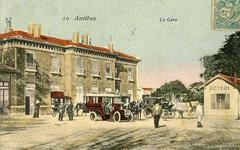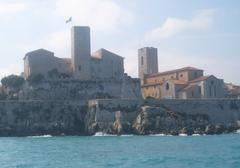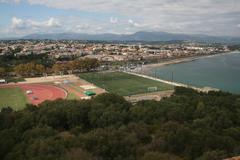Monument Aux Morts Antibes: Visiting Hours, Tickets, and Historical Significance
Date: 03/07/2025
Introduction
On the sun-soaked French Riviera, Antibes is home to several remarkable war memorials that commemorate the sacrifices of its citizens in the First World War and later conflicts. Chief among these is the Monument aux Morts, a profound symbol of remembrance, loss, and resilience. Set against the backdrop of the Mediterranean and the historic Fort Carré, this monument, along with other local memorials, embodies Antibes’ enduring spirit and its unique role in French memory culture.
The tradition of constructing Monuments aux Morts began across France after World War I, resulting in more than 36,000 such monuments by 1926—a testament to the country’s collective mourning and egalitarian values (Wikipedia). Antibes’ own memorials, including the iconic “Poilu” statue by Henri Bouchard, offer a local interpretation of this national movement and are integral to the city’s landscape and identity (laherrere.fr).
This guide provides detailed information about the Monument aux Morts in Antibes, including its history, visiting hours, accessibility, the significance of its design, and tips for making the most of your visit.
Origins and Design Philosophy
A National Tradition
After the devastation of World War I, communities throughout France erected Monuments aux Morts to honor those who never returned home. These memorials served as symbolic graves and reflected a commitment to egalitarian remembrance—names are usually listed alphabetically or chronologically, without regard to rank (Wikipedia).
Reflective and Egalitarian Values
Typical inscriptions such as “À nos morts” (“To our dead”) underscore a collective sense of loss rather than military triumph. This reflective approach is especially evident in the more than 700 memorials of the Somme region and is echoed in Antibes’ commemorative sites.
The Monument Aux Morts in Antibes: Features and Setting
Location
The main Monument aux Morts in Antibes is situated near the historic Fort Carré, on the Saint-Roch peninsula, offering sweeping views of both the city and the Mediterranean (laherrere.fr). Another significant site, the newly redeveloped monument at Place des Martyrs-de-la-Résistance, continues the tradition of commemoration in a central urban location.
Architectural and Artistic Highlights
- The “Poilu” Statue: Sculpted by Henri Bouchard, this 22-meter-tall figure is France’s tallest war memorial. The Poilu, depicted in detailed military uniform, stands in a pose symbolizing vigilance and sacrifice. A unique feature is the placement of his rifle on the left, a detail that has become part of local legend (laherrere.fr).
- Solid Stone Pedestal: The base anchors the monument both physically and symbolically, representing endurance and stability.
- Inscribed Names & Plaques: The names of Antibes’ fallen soldiers are inscribed on the base, personalizing the memorial and fostering a sense of community connection.
- Modern Marble Steles: At Place des Martyrs-de-la-Résistance, three Carrara marble columns and a quote by Louis Aragon invite visitors to reflect on the enduring meaning of sacrifice.
The monuments are designed to harmonize with their surroundings, integrating historical and contemporary elements that highlight Antibes’ narrative of defense and resilience.
Visiting Information
Hours and Tickets
- Monument aux Morts (Fort Carré): Open daily, year-round, during daylight hours (typically 8:00 AM to sunset). No ticket or entry fee is required (Evendo).
- Place des Martyrs-de-la-Résistance: Outdoor public space, accessible 24/7.
- Fort Carré: Open from 10:00 AM to 5:00 PM daily (closed Tuesdays). Entry fee applies for the fortress; the monument itself is viewable from outside (francethisway.com).
Accessibility
- Physical Access: Both main sites are designed with accessibility in mind. Flat, paved paths and nearby disabled parking make them suitable for visitors with reduced mobility (Provence Lovers).
- Sensory/Cognitive Accessibility: Antibes’ municipal policies support features such as tactile signage, braille panels, and audio guides at public sites. Information panels are being updated as part of ongoing redevelopment.
Facilities and Amenities
- Benches and shaded areas are available at both locations.
- Public restrooms can be found nearby, especially in the Marenda-Lacan district and close to Port Vauban.
- Numerous cafés, bakeries, and shops surround the squares.
Getting There
- By Foot: Both the Fort Carré and Place des Martyrs-de-la-Résistance are a short walk from Antibes’ Old Town and central train station.
- By Car: Paid underground parking is available nearby, such as Parking Pré-des-Pêcheurs and Parking Port Vauban.
- Public Transport: Local bus routes stop within a short walk of both monuments.
Guided Tours and Events
- Guided Tours: While there are no tours solely for the Monument aux Morts, local walking tours often include the memorials and Fort Carré. The Antibes Tourist Office provides up-to-date information and can recommend guides (Antibes Tourist Office).
- Community Events: Annual commemorations, especially on Armistice Day (November 11) and Victory in Europe Day (May 8), feature ceremonies at both monuments with participation from veterans, civic leaders, and school groups.
Tips for Visitors
- Best Times to Visit: Early mornings or late afternoons offer the most tranquil atmosphere and beautiful lighting. Major commemorative dates provide a unique opportunity to witness local traditions.
- Etiquette: As solemn memorials, visitors should behave respectfully—no climbing, littering, or disruptive behavior. Photography is allowed but should not interrupt ceremonies.
- Language: Interpretive materials are mostly in French, but English information is available at the tourist office. Many guides speak multiple languages.
- Footwear: Wear comfortable shoes, especially when visiting Fort Carré and the Old Town’s cobblestone streets.
Frequently Asked Questions (FAQ)
Q: Is there an entrance fee to visit the Monument aux Morts?
A: No, all outdoor memorials are free to visit.
Q: What are the opening hours?
A: The memorials are open during daylight hours, with the Place des Martyrs-de-la-Résistance accessible at any time.
Q: Are the sites wheelchair accessible?
A: Yes, both main monuments and their surrounding areas are designed for accessibility.
Q: Are guided tours available?
A: Yes, through the Antibes Tourist Office, often as part of broader city tours.
Q: Where can I park?
A: Paid parking is available at nearby lots, including Parking Pré-des-Pêcheurs and Parking Port Vauban.
Nearby Attractions
- Fort Carré: Explore the 16th-century fortress for panoramic views and a deeper dive into Antibes’ history (francethisway.com).
- Old Town: Wander through charming streets filled with markets, museums, and cafés.
- Port Vauban: Visit one of Europe’s largest marinas, steeped in maritime history.
Visuals and Interactive Resources
High-quality images, virtual tours, and interactive maps can be accessed on the Antibes Tourist Office website and related travel platforms. These resources help visitors plan routes and enhance their understanding of the sites’ significance.
Contact Information
For current updates on visiting hours, accessibility, and events, contact:
- Antibes Tourist Office: Place Guynemer, 06600 Antibes
Phone: +33 (0)4 22 10 60 01
Official Website
For news about ongoing construction or special events, check Nice Matin.
Conclusion
Antibes’ Monument aux Morts and its accompanying war memorials are more than static tributes—they are living sites of memory, integral to the city’s identity and educational life. Their accessibility, thoughtful design, and prominent locations make them essential stops for anyone seeking to understand the cultural landscape of the French Riviera.
Whether you wish to reflect on history, participate in community events, or simply appreciate the artistry and setting of these monuments, planning your visit with the latest resources will ensure a meaningful and respectful experience. For guided tours and updates, download the Audiala app and consult the Antibes Tourist Office.



